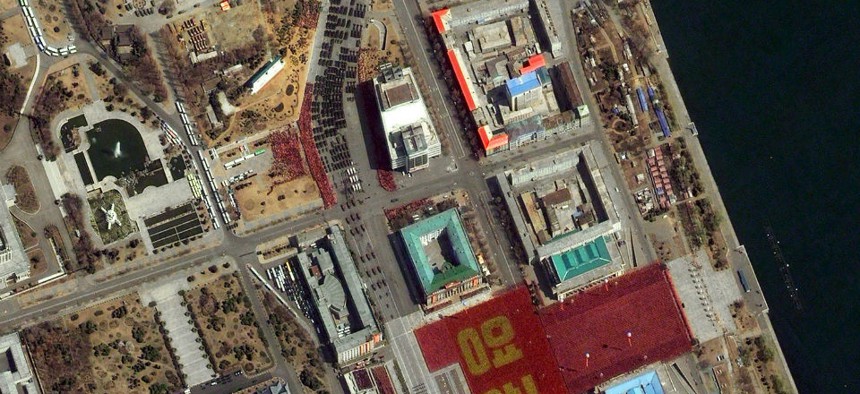Independent Experts Can Now Get Sharper Satellite Images of North Korea, Iran

A satellite image provided by DigitalGlobe shows a parade held to mark the 100th anniversary of Kim Il Sung's birthday Pyongyang, North Korea. DigitalGlobe/AP File Photo
Commerce OKs DigitalGlobe's license request to sell its highest-resolution photos to commercial clients.
Independent nonproliferation experts can now get images offering much greater detail about Iran's and North Korea's above-ground nuclear facilities.
Last week, the satellite company DigitalGlobe announced the U.S. Commerce Department had approved a long-standing license request to sell its highest-available resolution photographs to commercial clients. Previously, the U.S. government had forbidden the sale of images with a resolution better than 50 centimeters out of concern that doing so would hand an important intelligence tool to adversaries.
"We're very happy" about the decision, said Serena Kelleher-Vergantini, a research analyst with the Institute for Science and International Security, adding that she planned to purchase the new images "as soon as they are available."
One of the best tools independent experts have for assessing the status of nuclear and missile programs in countries like Iran and North Korea is analyzing satellite photographs of their weapon sites. However, the resolution of available photographs to date has meant that image experts frequently must hedge their pronouncements, offering a number of possible scenarios that could explain the meaning behind various blurred objects.
"With closer resolution, you are capable of distinguishing items between each other," Kelleher-Vergantini said, noting that one of her big challenges with the currently available commercial satellite imagery is trying to distinguish vegetation from black vehicles.
Also often difficult to discern are ventilation systems on nuclear plants, said the Washington-based analyst.
With currently available images "you can see buildings and determine their sizes and stuff ... with pretty high certainty," she said in a Friday phone interview. "But anything smaller, we can see cars but you're never capable of determining what type of car it is."
Another outfit that relies heavily on satellite images for its analysis of North Korea's nuclear and missile programs is the expert website 38 North.
Joel Wit, who edits the site, told Global Security Newswire he thinks having access to higher-resolution images will "help improve analysis," but that it would help more if DigitalGlobe were to sell a greater quantity of images taken of key weapon sites. "The [current] coverage is very spotty. Sometimes you can go for weeks without any pictures."
DigitalGlobe sought authorization to sell images with a higher resolution out of a desire to protect the company's market share at a time when foreign-owned companies are preparing to launch their own advanced imaging satellites, according to SpaceFlight Now.
DigitalGlobe presently has four operating satellites; a fifth, WorldView 3, is expected to launch in mid-August. The Colorado-based company's updated license allows it to immediately begin selling images with a resolution of 40 centimeters. Once WorldView 3 begins transmitting, the company will be able to sell photographs with a 31-centimeter resolution, according to Turner Brinton, DigitalGlobe spokesman.
The new license permits the sale of images with a resolution of up to 25 centimeters, but Brinton said in order to provide that kind of detail, the company would need to lower the planned orbiting altitude of the Worldview 3 satellite -- something it does not have any immediate plans to do.
NEXT STORY: Why Tesla Gave Up on Patents



